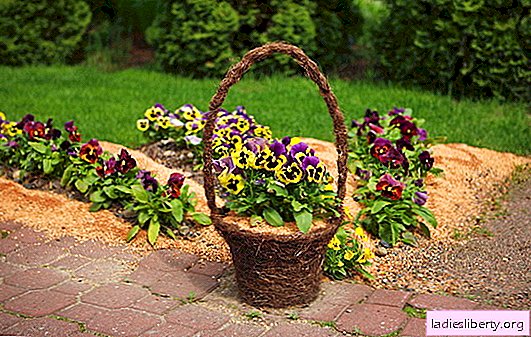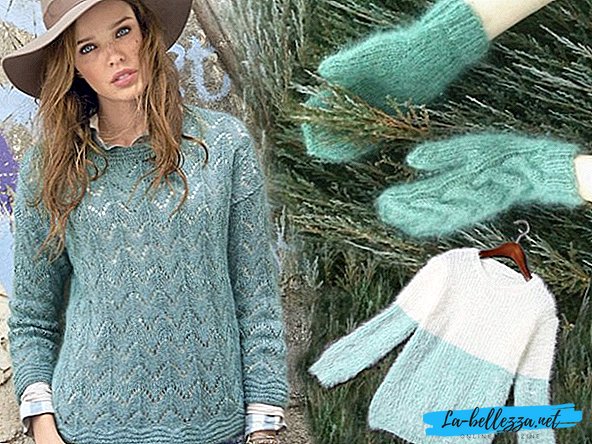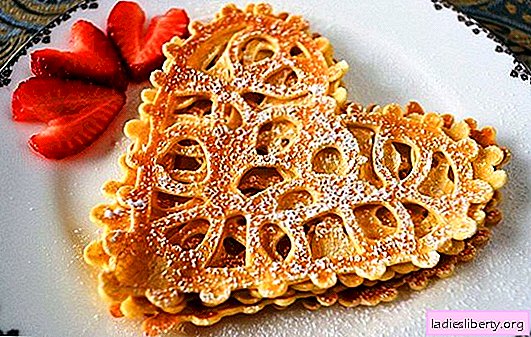
Pansies - this is a cultivated flower grown in gardens, in summer cottages and is a colorful annual, biennial or perennial plant of the violet family.
In height, this plant reaches 25-30 cm.
The color of these flowers and the presence on the main background of the petals of multi-colored spots completely depends on a particular plant variety.
Pansies, acting as a garden flower, are derived from wild field plants belonging to the genus Viola.
"Pansies" are divided into two main types - simple varieties and tricolor.
To date, more than 250 species of cultivated varieties of Pansies are known.

Features of growing a flower called Pansies
Features of growing pansies:
• Pansies prefer to grow in sunny places.
• Plants are characterized by good endurance and can survive even with the onset of small frosts and snowfalls.
• After planting pansies with seeds, the plant in the first year of life gives the amateur gardener only an abundance of greenery and only in the second year gives flowers and seeds.
• Water pansies, depending on weather conditions, 1-2 times every two weeks.
• Fertilizing pansies is applied weekly for better bud formation and flowering.
• You also need to remember that pansies should be planted on areas warmed up and shined with the sun for at least 6 hours a day.
Pansies: planting, variety selection
Pansies can be grown both in autumn and winter. Knowledgeable gardeners recommend planting seeds in the premises in July, and after two months, ready-made seedlings are transferred to the ground along with the root tuber of the earth, after the heat has gone and coolness has set in.
Any action to be taken when planting these flowers is necessary in the shade, when the sun goes beyond the horizon, and the soil is moistened and enriched with humus. It is necessary to plant pansies at a distance of 20-25 cm from each other, since the bush tends to grow in the future.
Pansies, the planting of which requires the observance of certain rules, for example, adding the necessary fertilizer and bone meal to the soil, are still not very whimsical to care for, which is attractive for gardeners. The main thing is to provide these flowers with watering, especially after planting in the ground, nourishing the soil around the plants for several centimeters with a mulching layer and further care aimed at sheltering the seedlings from the wind and low temperatures.
Important! It is necessary to plant pansies so that the top of the earthen coma on the roots coincides with the ground level in the landing site.
Pansies are divided into:
• On small;
• Large-flowered;
• Gigantic varieties.
These varieties differ among themselves by the length of the stem, the size and color of the flower, but they have similar growing conditions and can be planted in any region.
The most popular types of pansies are:
• "Fire king" - a small hybrid with purple-yellowish buds.
• "Abendglut" - a large-flowered variety with a small bush height and large up to 6-8 cm in diameter flowers of a dark red color with brown spots.
• "Ice king" - a variety with bright white flowers.
• "Weiss" - a gigantic variety with pure white flowers and a wavy frame.
• "Himmelstigen" - a hybrid represented by blue flowers.
Important! All of these varieties tend to cross-pollinate, which gives subsequent generations characteristics that do not always delight lovers of these marvelous colors.
Pansies: care (photo)
Color arrangement
For proper care of pansies, it is necessary, first of all, in the sultry time and heat to shade the plant from direct sunlight, the ingress of which negatively affects the growth of buds, delaying it. Places where pansies grow should be ventilated, and the soil moistened.
Soil and watering pansies

Caring for pansies, it is necessary to provide these flowers with soft and loosened soil, which should also be saturated with organic substances. In addition, the soil for the growth of pansies must be fertilized, and the flowers are fed.
In order for pansies to grow large and with richly colored petals, these flowers need to be provided with frequent watering. Between watering, the soil should dry well, so that water does not stagnate and the root system does not rot.
Pansies - flower care and important points:
• In order to prolong flowering, it is necessary to remove all wilted flowers from the bush with constant regularity so that seeds do not form.
• It is necessary to pinch elongated and unsuccessful shoots.
• If the pansies begin to dry out, it is necessary to trim the plant and properly feed the bushes.
The proper care of pansies will give them the opportunity to give lovers of these plants amazing and colorful flowers.
Pansies: top dressing
Fertilizing pansies must be applied regularly, namely to carry them out in the season at least two times. The main dressing is carried out when the plant is picking up buds with fertilizers such as nitrophoska and Agricola. Subsequent feeding is done during the rapid flowering of the plant, using a fertilizer called "Agricola-7".
To feed pansies, you need mineral fertilizers with potassium, nitrogen, phosphorus and other trace elements that make up their composition. After planting, seedlings need to be fertilized with superphosphate, nitrate. Fresh manure to the soil, where pansies live, is prohibited.
From the moment of lowering the temperature, the amount of top dressing is reduced and, preparing the plant for wintering, cover the flower bed with sawdust, peat or other insulation.
Pansies: diseases and pests (photo)

Very often, gardeners are faced with diseases and pests of pansies. This flower is quite susceptible to both diseases and the invasion of harmful insects.
Here are the most common ones:
• Powdery mildew - on leaflets and stalks of plants, it manifests itself, forming a whitish coating on them. The green of the flower turns brown. If the initial stage of this disease is detected, it is necessary to treat the pansies with fungicides. If the disease is already progressing, you can use tools such as Chistotsvet or topaz. The most affected plants must be removed without regret from the beds or flower beds.
• Gray rot - as a result of this ailment, a grayish coating appears on pansies, leaves and stems become soft and watery. This disease often appears due to strong humidity, is rapidly developing and affects the entire seedlings. If this problem occurs, the gardener needs to remove the affected plants, reduce watering and the temperature of the greenhouse, or treat with a product called Fundozol.
• Bacterial spotting - manifests itself as yellow or brown spots, which almost completely cover the leaves of the plant. It is recommended to remove diseased plants from the flowerbed, and treat healthy bushes with copper oxychloride.
• Aphid - about the defeat it can be found on the drying and yellowing leaves, buds of plants and its sticky secretions. The flowers of the plant die, and can cope, with the invasion of aphids it is possible only by spraying with soapy water or "ActellikZubr".
• Slug - the appearance of holes and grooves on the leaves of the plant, this is what determines the pest. In the fight against snails and slugs, you can cope by reducing watering and organizing the collection of pests manually. If the plants are severely affected, then they can be treated with metaldehyde.
Caring for pansies in principle is not difficult, the main thing is to know the basic rules and, according to them, to grow these unpretentious, but charming flowers. And then thanks to pansies the garden will become a bright attraction and pride of any gardener.











